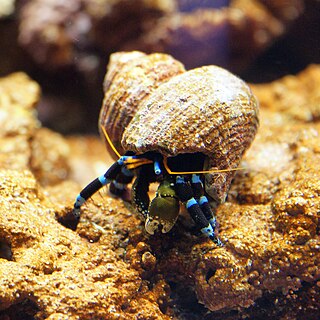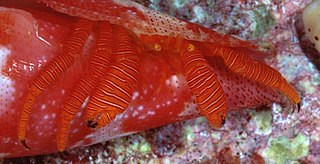
The halloween hermit crab, also known as the striped hermit crab or orange-legged hermit crab, is a brightly colored aquatic hermit crab of the family Diogenidae. Besides its ability to routinely clean algae in aquaria, the halloween hermit crab's festive striped coloration also appeals to enthusiasts; it is considered the most brightly colored hermit crab in normal aquarium use.

The Diogenidae are a family of hermit crabs, sometimes known as "left-handed hermit crabs" because in contrast to most other hermit crabs, its left chela (claw) is enlarged instead of the right. It comprises 429 extant species, and a further 46 extinct species, making it the second-largest family of marine hermit crabs, after the Paguridae.

Calcinus is a genus of hermit crabs in the family Diogenidae, containing the following species:
Ciliopagurus albatrossi is a species of hermit crab native to the Hawaiian region.
Ciliopagurus alcocki is a species of hermit crab native to New Caledonia.
Ciliopagurus babai is a species of hermit crab native to Wakayama.
Ciliopagurus haigae is a species of hermit crab native to Tanzania.
Ciliopagurus liui is a species of hermit crab native to the Gulf of Tonkin and waters to the south of Japan.
Ciliopagurus macrolepis is a species of hermit crab native to Indonesia.
Ciliopagurus major is a species of hermit crab native to French Polynesia.

Ciliopagurus pacificus is a species of hermit crab native to French Polynesia.
Ciliopagurus plessisi is a species of hermit crab native to French Polynesia.
Ciliopagurus tricolor is a species of hermit crab native to Madagascar. It is one of four species in the "strigatus complex", having morphological similarities to C. strigatus, with the most prominent variance being coloration.
Ciliopagurus caparti is a species of hermit crab native to South East Atlantic.

Ciliopagurus galzini is a species of hermit crab. It is one of four species in the "strigatus complex"; it resembles C. strigatus, with the most prominent difference being coloration. It is common in the shallow intertidal waters of the Tuamotus.
Ciliopagurus krempfi is a species of hermit crab from the Indo-Pacific.
Ciliopagurus substriatiformis was a species of hermit crab that existed during the Badenian stage.
Ciliopagurus vakovako is a species of hermit crab native to the Marquesas Islands. It is typically found at a depth no lower than 57 metres (187 ft). C. vakovako appears to be a vicariant of C. strigatus, a species widespread throughout the Indo-pacific region.

Aniculus maximus, the hairy yellow hermit crab or large hairy hermit crab, is an aquatic hermit crab of the family Diogenidae.
Calcinus revi, commonly known as the white hermit crab, is a species of hermit crabs in the family Calcinidae.






